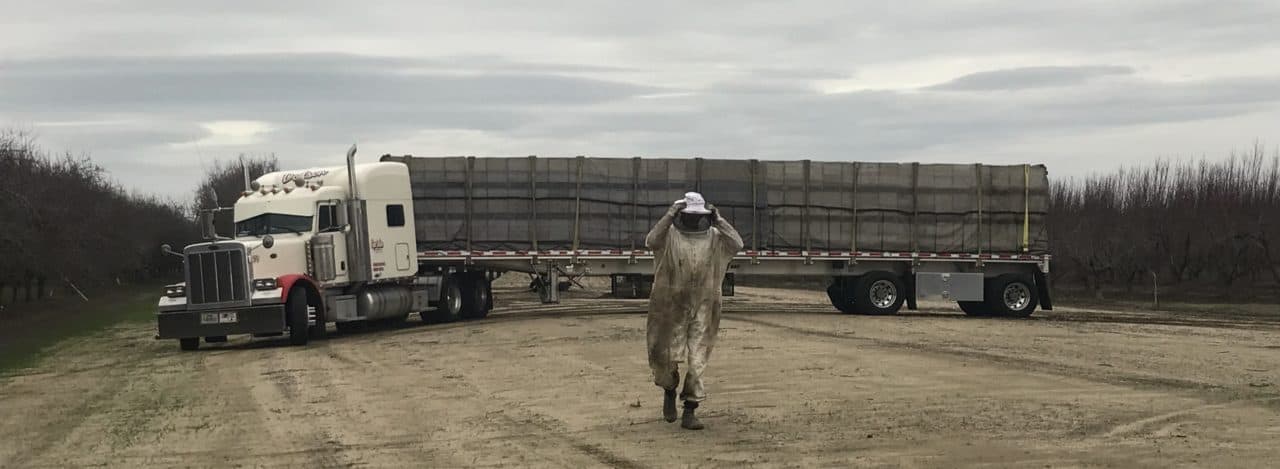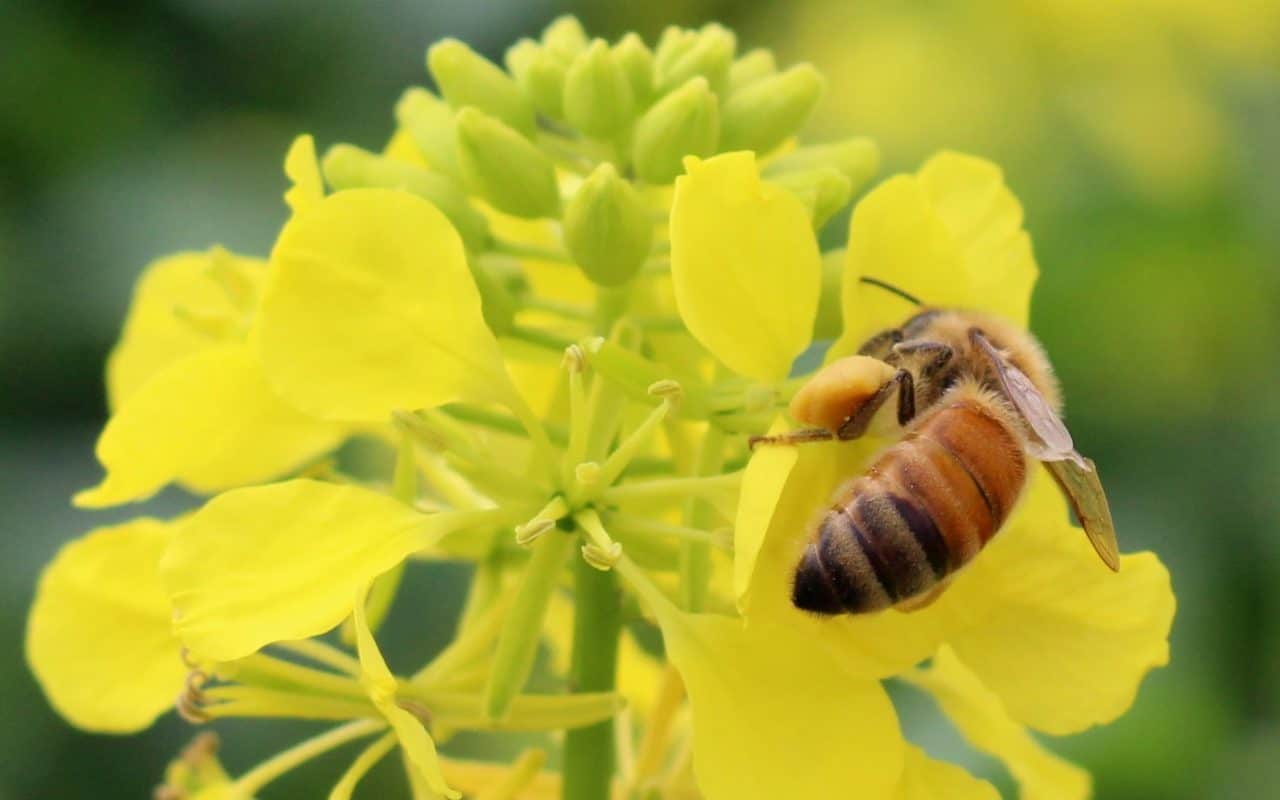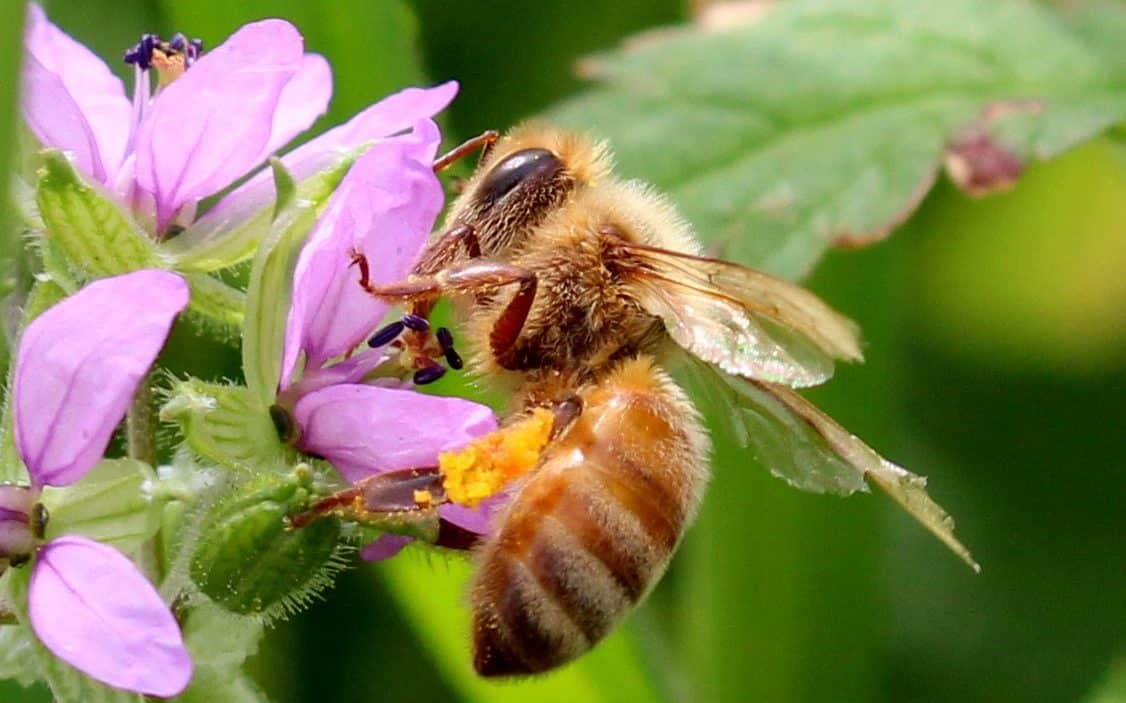Every year, beekeepers from across the continental United States move millions of honey bee colonies to California’s Central Valley, arriving just in time to tend the billions of bursting almond blossoms that require their pollination services. But have you ever really thought about what it takes to accomplish this massive migration? Colonies from every corner of the country - many hunkered down in the dead of winter, or stacked in indoor, cold storage sheds - are prepped and loaded onto semis, hauled hundreds of miles, inspected at border stations, unloaded into temporary holding yards, and then relocated once more - strategically placed amongst the almonds…
Category: Pollination
A Bee on the Wall: Transporting Honey Bee Colonies to California for Almond Pollination
Written by Grace Kunkel and Sharah Yaddaw, Project Apis m. team members Taking honey bees out of indoor storage (or an over-wintering apiary) and transporting them to California in time for almond pollination is a massive, coordinated effort that commercial beekeepers undertake every year. It isn’t just the beekeepers that make it happen; experienced truck drivers, state inspectors staffing points of entry into California, and almond growers all coordinate for this event. Most importantly, mother nature determines the exact timing of the almond bloom and the driving conditions the truck drivers must navigate to get there. Project Apis m.’s Director of Communications, Sharah Yaddaw, along…
Honey Mustard or Mustard Honey?
Honey bees need an abundance and diversity of floral resources to grow and thrive throughout the season. In areas of intensive agriculture, like the almond orchards of California, forage can be scarce before and after the primary cultivated crop blooms. One of the pollinator friendly plants that is often seen in and around orchards and agricultural fields is mustard. The common appearance is due to both deliberate planting as a cover crop and the plant spreading through self-sowing. There is a great deal of research going into developing cover crop seed mixes to supplement forage before and after almond bloom. Many of these seed mixes…
A Look At Filaree As A Forager Food
The vast majority of the commercially managed honey bee colonies in the United States spend February and a portion of March pollinating almonds in the central valley of California. Almond pollen is very nutritious, and colonies build well on it when favorable weather conditions prevail during bloom. The weather during almond pollination season in 2020 was very favorable, and colonies made significant increases in both population and food reserves during the bloom period. While warm and dry conditions this year led to a good nut set, it did mean that bloom progressed quickly, and once finished there were limited flowers available. By working in various…
The NEW Honey Bee Discovery Center in Orland
A few weeks ago, I was invited to the Honey Bee Discovery Center Kick-off and Exhibit Preview in Orland, California. This event was followed by the Queen Bee Festival the day after. The Honey Bee Discovery Center is ‘the first interactive exhibit and museum of its kind’. It highlights the history of beekeeping from hobbyists, sideliners and commercial operators’ perspectives, and features the evolution and breakthroughs in equipment, pollination and art inspired by bees. Inside the center, one can find multiple showcases of vintage bee equipment related to all apicultural activities, complete with an observation hive near the center of the room. All around the new…
2019 California Spring Update
Many California beekeepers reported that the start of this year was the worst in 20+ years. Several factors contributed to this year’s issues, starting with the numerous fires last year causing nearly 3 months of smoke in the area. Once the days got longer, queens started laying but the temperatures dropped again and egg laying stopped once more resulting in smaller colonies after almonds. In fact, most colonies were 2-3 weeks or even a month behind, which delayed the start of queen production. Many producers had to source bulk bees from beekeepers further south to begin starters, builders and nucs. Once queen producers started generating…
Almond Math
There are plenty of quick stats you come across working around bees: At peak population, a strong colony can have over 60,000 individual bees. A queen is capable of laying more eggs in a day (up to 2,000) than there are minutes in a day (1,440). A single bee can produce 1/12 tsp honey in its lifespan and may cumulatively travel 500 miles during the several weeks it spends as a forager. Despite annual losses in the 30-40% range, the total managed colony numbers remains fairly constant at about 3 million. The American bee industry is inextricably linked to the almond industry. Every year, about…
It’s Cold (and Wet) Out There
I don’t know what the groundhog did or saw this year, but according to the calendar it’s still winter. The first day of spring is still a month away. If you’re a pollinator or grower of almonds, you’re hoping weather conditions up and down the central valley of California become more favorable for flight activity than they have been. I recently returned from 2 weeks of inspecting and sampling colonies where conditions were cold, wet, and windy. These conditions delayed onset and slowed progression of the almond bloom and are forecast to continue. Frequent updates on the progression of bloom and conditions for flight…
Bee Understanding
Earlier this year I had the opportunity to take part in the filming of a documentary by the Bee Understanding Project and it turned out to be a very fun and informative experience! The point of the film was to show the relationship between the almond and beekeeping industries through a job swap, where each participant, almond grower and beekeepers, could better see the other’s perspective. Unlike many other recent honey bee documentaries, this film does not portray commercial beekeepers or almond growers as the bad guys, but rather is fair in describing the challenges each of them faces as our agricultural systems become more…
Wintering Sheds: Why are more North American beekeepers overwintering their bees in cold storage?
More and more US beekeepers are starting to place their bees in sheds for the fall, for indoor wintering. While beekeepers in Canada have done this for decades, the popularity of the practice in the US is more recent. Beekeepers began by using structures already built for onion and potato storage in Idaho to house their bees in the fall. One Stop Self Storage was built with an intent to help beekeepers and to create good environment for bees .These beekeepers then remove the bees in January, and bring them to California for almond tree pollination. Many beekeepers are still using old potato and onion…



